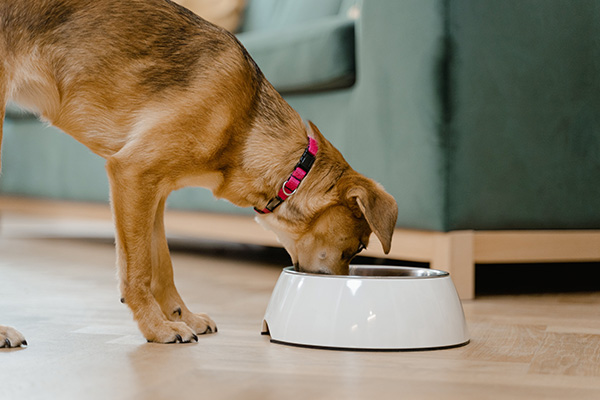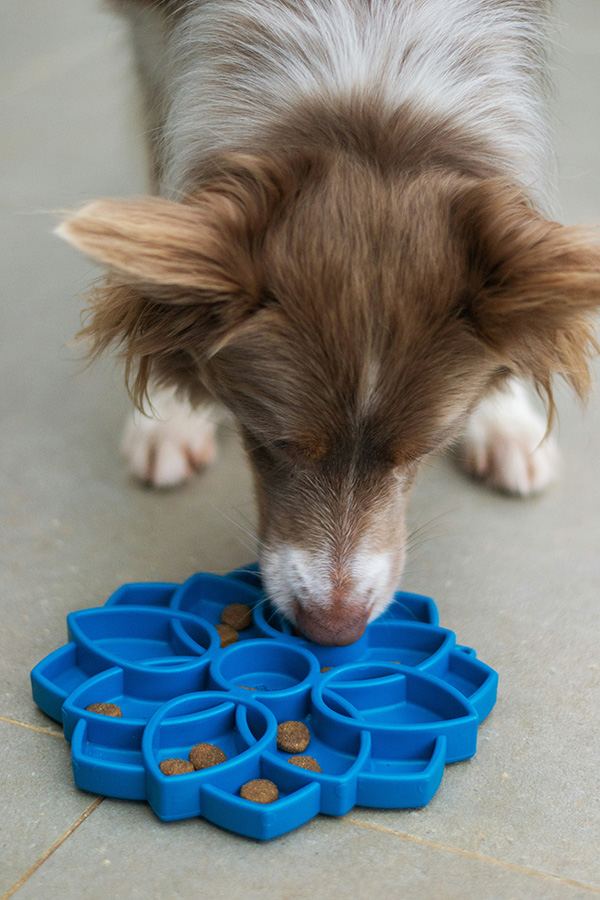Slow feeders are revolutionizing the way we feed our canine companions, addressing a crucial aspect of dog health and behavior. Fast eating is not just a minor issue; it's a widespread concern among dog owners, leading to problems like bloating, obesity, and poor digestion.
In this article, we will explore the advantages of incorporating a slow feeder into a dog's feeding routine. By turning mealtime into a stimulating activity, slow feeders not only encourage healthier eating habits but also enhance mental stimulation, reducing the risk of digestive issues and weight gain.
Benefits of Slow-Feeder Dog Bowls
Promotes Healthy Eating Habits
Whether you are using dog slow feeders for raw dog food or kibbles, they can help promote healthy eating habits, which is a key benefit of using slow-feeder dog bowls. These innovative bowls are designed to restrict the amount of food a dog can consume at once, encouraging them to eat more slowly. Slower eating plays a crucial role in improving digestion and facilitating better absorption of nutrients. Dogs that eat slowly are less prone to digestive discomfort like gas or indigestion and can more effectively process and utilize the nutrients from their meals. This approach not only benefits the dog's physical health but also instills a calmer, more disciplined eating behavior, which is essential for their overall well-being.
Reduces Risk of Bloat
Slow feeder dog bowls are instrumental in reducing the risk of bloat, a serious and sometimes fatal condition in dogs. Bloat, or gastric dilatation-volvulus (GDV), is primarily triggered by the rapid consumption of food and air. Dogs, when eating too quickly, often ingest significant amounts of air and food. This can result in the swift expansion of the stomach and, in severe instances, its twisting on itself, a critical condition necessitating immediate veterinary attention.
The clever design of slow feeder bowls compels dogs eat at a slower pace and help your dog eat better, thereby significantly reducing the amount of air ingested during feeding. This slower pace of eating is crucial in preventing the stomach from bloating and twisting. By encouraging slower and more deliberate eating habits, a slow feeder bowl not only enhances the eating experience of dogs but also serves as a vital tool in safeguarding their health against this dangerous condition.

Enhances Mental Stimulation
Enhancing mental stimulation is a standout benefit of slow-feeder dog bowls, offering dogs more than just a mealtime experience. These bowls, crafted with intricate ridges and mazes, turn a simple act of eating into a stimulating mental exercise.
Dogs are natural problem-solvers, and slow feeder bowls tap into this instinct by challenging them to navigate their way to their food. This added mental engagement is crucial for dogs, particularly those who spend a lot of time indoors or have limited opportunities for physical exercise. The mental workout provided by these bowls helps in reducing boredom and associated negative behaviors, such as destructive chewing or excessive barking.
Moreover, this form of cognitive stimulation is beneficial for dogs of all ages, supporting mental agility in younger dogs and helping maintain cognitive function in older pets. By making mealtimes both fun and thought-provoking, slow-feeder bowls contribute significantly to the overall mental well-being and happiness of dogs.
Helps with Weight Management
Slow feeder dog bowls are crucial in weight management, a significant aspect of canine health. Excessive food intake is a prevalent issue among dogs, contributing to obesity and associated health concerns. These bowls are designed to slow the speed at which dogs consume their food, addressing this concern effectively.
By prolonging the eating process, slow feeders help dogs recognize the feeling of fullness, reducing the likelihood of overeating. This is particularly beneficial for dogs on a calorie-controlled diet, as it extends the duration of their meals, helping them feel satiated for longer periods.
Moreover, the gradual eating pace facilitates improved digestion and absorption of nutrients, promoting a healthy metabolism. The mental engagement provided by the bowls also diverts attention from the quantity of food, making mealtime more about the challenge and less about the amount consumed. This approach to feeding not only helps in maintaining an ideal weight but also instills healthy eating habits in dogs.
Improves Dental Health
Slow feeder dog bowls offer significant benefits for dental health, an often-overlooked aspect of canine well-being. These bowls feature intricate patterns and obstacles that encourage dogs to eat slower and chew their food more thoroughly. This extended chewing process is vital for dental health.
While dogs chew, the mechanical action aids in scraping away plaque and tartar build-up on their teeth, fostering healthier gums and diminishing the risk of dental diseases. Moreover, the act of chewing stimulates saliva production, which further aids in the natural cleansing of the mouth and teeth.
In addition to averting oral health problems, thorough chewing promotes better digestion, as the process of breaking down food initiates in the mouth. By encouraging dogs to chew their food properly, slow feeder bowls contribute to maintaining good oral hygiene and supporting the dog's overall digestive health. This simple feeding tool thus plays a dual role in enhancing both dental and digestive wellness in dogs.
Fun and Engaging
A slow-feeder dog bowl can transform ordinary meal times into fun and engaging activities for dogs, making them more than just a feeding tool. The unique designs of these bowls, with their ridges, grooves, and mazes, turn eating into an interactive game. This playful aspect is especially beneficial for dogs, as it caters to their natural foraging instincts and curiosity.
Dogs are not just passively eating; they are mentally and physically engaged in accessing their food, which can be incredibly satisfying and enjoyable for them. This form of enrichment is particularly important for high-energy breeds or dogs that spend a lot of time indoors, as it provides a constructive outlet for their energy and intellect.
The challenge of reaching the food keeps them entertained and engaged, preventing boredom and potentially destructive behaviors. By infusing mealtime with an element of play and mental stimulation, slow-feeder bowls enrich the daily lives of dogs, contributing to their overall happiness and well-being.

Prevents Resource Guarding
A dog slow feeder bowl can effectively mitigate resource guarding behaviors in dogs, a common issue linked to feeding. Resource guarding, where dogs become overly protective or aggressive around their food, often stems from anxiety and the instinct to consume meals rapidly.
Dog slow feeder bowls, with their complex designs, necessitate a slower eating pace, which can help alleviate the urgency and stress a dog might feel while eating. As dogs learn to have ample time to eat and that their food is not under threat, the likelihood of guarding behavior decreases. This change in eating dynamics fosters a more relaxed mealtime environment.
Dogs become accustomed to a calm and prolonged feeding process, which can significantly reduce their perception of food as a scarce resource that needs aggressive protection. Implementing a slow feeder bowl not only enhances the physical health of dogs but also plays a crucial role in improving their behavioral well-being, creating a more harmonious and stress-free feeding experience.
Prevents Choking and Vomiting
Slow-feeder dog bowls play a pivotal role in preventing vomiting and choking, two risks associated with rapid eating. By design, these bowls create a labyrinth of sorts for the food, significantly slowing the eating pace. This slower pace allows dogs to chew their food more thoroughly, aiding in digestion and reducing the likelihood of vomiting that often occurs from gulping down food too quickly.
Additionally, the intricate structure of slow feeders prevents dogs from taking large bites, thereby reducing the risk of choking. This is especially important for eager eaters who tend to swallow without proper chewing. Slow feeders promote a healthier and more enjoyable meal experience for dogs by promoting a safer, more deliberate eating process.
Aids in Training and Behavior Modification
Using a slow feeder dog bowl can effectively aid in training and behavior modification for dogs. These bowls encourage dogs to eat more slowly and patiently, teaching them impulse control and discipline around meal times. This is particularly beneficial for dogs that exhibit over-enthusiastic eating behaviors or show signs of food aggression.
The slow feeder’s design, which often includes obstacles or mazes, requires dogs to navigate their way to the food, fostering a more mindful and focused approach to eating. This practice can translate to better behavior in other aspects of their lives as the dogs learn to approach tasks with greater calmness and concentration. Integrating a slow feeder dog bowl into a dog’s routine can thus be a simple yet effective tool in shaping desirable behaviors and enhancing overall training efforts.
